The 5 Facebook Bidding Strategies Explained: Pros, Cons & How to Choose
It is relatively safe to say that many advertisers don’t give much thought to Facebook (Meta) ads bidding strategies. However, there is much more to the platform than the “set it and forget it” attitude that the majority of novice marketers carry. I’ve stated before that putting all your trust into these digital ad networks (tech giants) to make decisions for you is a slippery slope, but how much of this is true when it comes to Facebook bidding strategies? In this post, I will shed some light on bidding on Facebook and what I believe is necessary in order to properly compete.
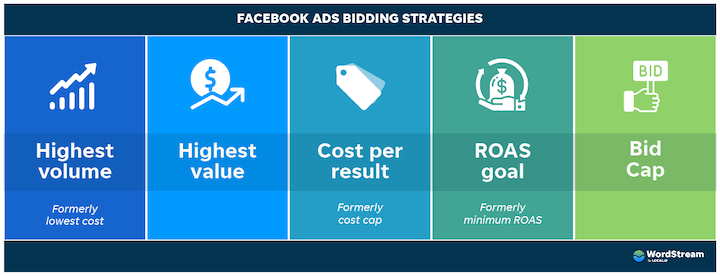
Table of contents
- Facebook bidding and the ad auction
- How important is your Facebook bidding strategy?
- The five bidding strategies in Facebook ads
- Which bidding strategy is best?
Facebook bidding and the ad auction
When you choose a bidding strategy in Facebook advertising, you’re choosing how you want Facebook’s algorithm to bid for you in ad auctions. That is, when you set a campaign, ad set, or ad live, how you wish to compete within the auction to ensure that your ad is being presented to the right people at the right time—according to your budget and business goals.
And this all boils down to understanding the ad auction that takes place.
Whenever there is an opportunity to show an ad to someone, any advertisers who have that individual in their Facebook ad targeting are entered into the auction. This is often why costs are much higher for smaller audiences—as competition is higher. Competition gets higher during the holiday season as well, which is why general costs to advertise during this time also increase.
According to Meta, “To ensure that the winning ad maximizes value for both people and businesses, the winner of the auction is the ad with the highest total value.” The “total value” is comprised of three main components:
- Bid: Quite simply the bid is how much you are willing to pay to receive your desired advertising outcome.
- Estimated action rates: An estimate of whether a specific user with engage or convert from a particular ad. Essentially, the probability that showing a particular ad will derive the desired outcome from the user.
- Ad quality: A measurement of feedback from users and other ad attributes such as withholding information, sensationalized language, and “engagement bait.”
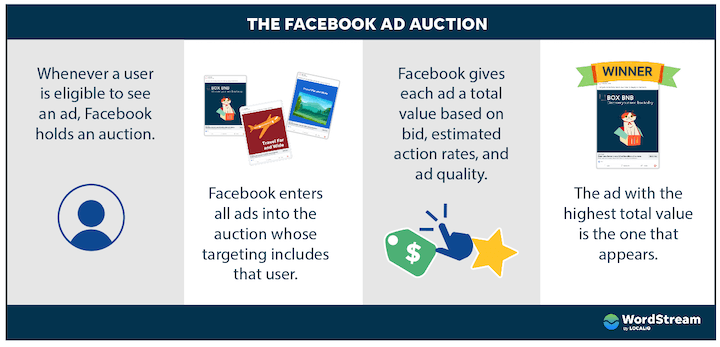
The last two components of “total value” for Facebook ads come down to your proficiency in marketing what the goal that you desire is. On the other hand, the first component is a bit more straightforward.
How important is your Facebook bidding strategy?
When it comes to online advertising, there has always been an inherent obsession and neuroticism around bidding strategies, regardless of the platform. This mainly stems from the naive belief that it’s what you can control most within these platforms.
I say naive because there are countless other things you can control in your ad strategy that are equally as important, and they almost always come down to basic marketing fundamentals. If your ad copy, creative, and targeting are not well-thought-out, it doesn’t matter what bid strategy you go with.
🔷 Speaking of fundamentals…
Free guide: The 7 Facebook Advertising Fundamentals
However, let’s say you have all those components in alignment, then bid strategy now plays a much bigger role in the overall success of your ads.
Facebook bidding strategies
With Facebook, there are three general forms of bidding strategies that you can leverage to get the most out of your campaigns and optimize toward your goals: spend-based, goal-based, and manual. They include:
- Highest volume (formerly lowest cost)
- Highest value
- Cost per result (formerly cost cap)
- ROAS goal (formerly minimum ROAS)
- Bid cap
Spend-based bidding strategies
Spend-based bidding is the most simple and generally the default when you select a campaign objective. The basic premise of this bidding structure is: “focus on spending your full budget and getting the most results or value possible.” There are two subsets to this strategy:
1. Highest volume
Delivery is maximized for conversions with the budget that you assign. Essentially, you tell Facebook to get you as many results for a specified amount of budget to be spent. This is similar to Maximize Clicks bidding in Google Ads.
This strategy is best for those who want to spend their full budget and who don’t have a specific cost per action (CPA) or return on ad spend (ROAS) goal. If auction competition decreases, your CPA may go down, but if it increases, your CPA may go up.
2. Highest value
This one has more of an ecommerce/ROAS focus as it spends your budget but focuses on highest-value purchases or conversions. For example, a seller may use this to sell a higher-valued item to maximize the value and return on ad spend. This focuses on conversion value over conversion volume (just like max conversion value bidding in Google Ads).
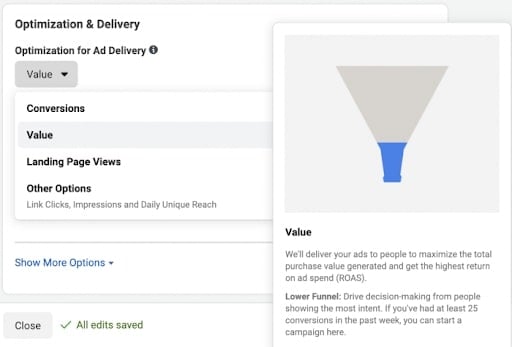
While this strategy will help you to spend your whole budget while also getting higher quality conversions, keep in mind that you will need to have conversion tracking set up as well as conversion values assigned to your offerings.
Goal-based bidding strategies
Goal-based bidding allows you to set a cost or value you want to achieve.
3. Cost per result bidding (formerly cost cap)
Just as its name implies this bidding strategy aims to maintain an average cost per result that you specify. This is helpful if you understand the maximum cost per conversion or result you can incur while maintaining profitability from advertising.
Keep in mind that the cost you specify is what Facebook will strive to average out to over the campaign’s lifetime. This means your cost per result could fall short of that value on one day or exceed it on the next.
Also, if you set it too low, it may take longer for Facebook to spend your budget and get out of the learning phase. It’s not until Facebook is out of the learning phase that it can really start optimizing ad delivery. Until then, there will be fluctuations in costs and performance. This strategy is best if you have a clear idea of your average CPA. If you’re not sure, try highest volume bidding for a little while to get a baseline.
4. ROAS goal (formerly minimum ROAS)
Return on ad spend is a popular bidding strategy for those whose conversions yield a direct amount of revenue. Ecommerce businesses typically gravitate towards this strategy as it is a means for ensuring that their advertising remains profitable as the goal is directly tied to sales. For those who are acquiring conversions that do not directly result in money earned, this strategy is less popular as it may be difficult to assign a conversion value.
Keep in mind that if you are new to advertising on Facebook, you’ll either need to verify your business or be running ads for a few weeks first.
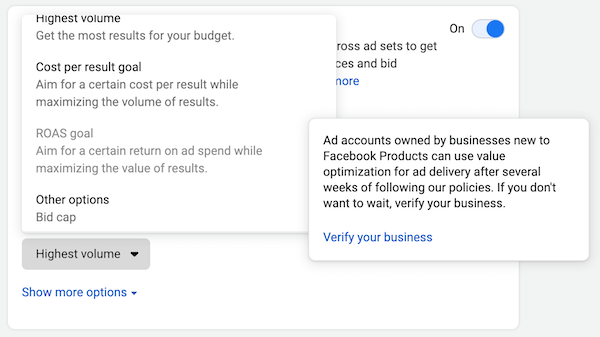
ROAS goal is different from highest value because it does not guarantee Facebook will spend your full budget. It will strive to get you the most opportunities possible within that ROAS value.
Manual bidding in Facebook
Manual bidding is a very old school (and some might say dying) strategy that allows you to control how much you wish to bid across ad auctions.
5. Bid cap
This bidding strategy allows you to set the maximum bid for your ads across auctions. This is opposed to allowing Facebook to dynamically bid for you against other advertisers. You would choose this bid strategy if you have a strong understanding of your Facebook ads costs, confidence in your conversion rates, and the ability to calculate the proper bid.
Which Facebook bidding strategy is best?
I’ve broken out two categories of businesses and their goals on Facebook and which strategies I believe will work best for them:
Suggested bidding strategies for lead generation businesses
Many, if not most, advertisers use Facebook ads with a lead generation focus. That is, the offers for their ads are not for direct purchases, but for things like content downloads, free trials, or consults. The ads direct users to a landing page or in-platform lead form in order to collect user information.
I work with many of these advertisers and Facebook is a great platform to achieve low-cost leads that ultimately make their way through the funnel to sales. This means that the conversions don’t have a direct monetary value assigned since they’re not purchases.
For this objective, my advice would be to either use highest volume or cost per result. Most businesses that I work with tend to be fairly successful with the former, particularly when an ideal cost per conversion is unknown at the given time. If you do have the entire marketing funnel mapped with costs and conversion rates, then having a target cost per action would make more sense. It comes down to the sophistication of your lead generation process and marketing and sales operations.
Suggested bidding strategies for ecommerce businesses
Now if you’re running ads that lead users to complete a purchase with a fixed dollar amount, then I would suggest using cost per result, ROAS goal, or highest value.
Since your conversion actions have a concrete “value” assigned to them, your goal isn’t necessarily to maximize conversion volume through spend but to maximize the profitability of your ad spend.
🔷 Find more ways to get the most for your budget using the free Facebook Ads Grader.
My preferred bidding strategy for ecommerce clients is ROAS goal as it allows us to plan and strategize according to what is going to make us most profitable with the ad spend that we have.
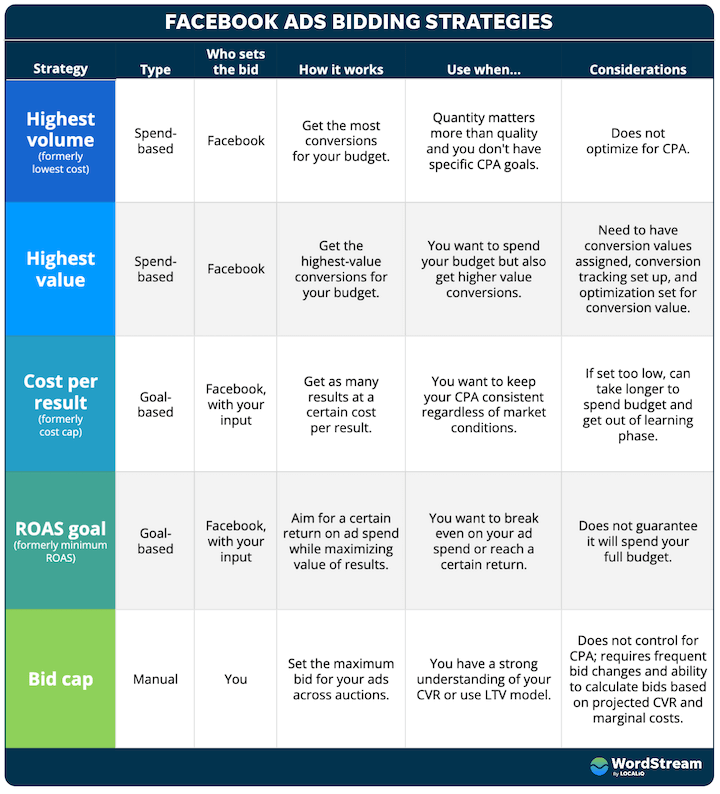
Don’t overthink things
I speak a lot about how mistrusting I am about these tech giants (Google and Facebook) and how their biggest priority is spending your money through the guise of “automation.” Although I do believe that to some extent within reason, I also understand that Facebook’s algorithm, when given the proper input, can work wonders.
So when it comes down to bidding strategies within Facebook, I’m more inclined to advise folks to stick with the least complicated approach. As stated previously within this post, most of my clients operate on a highest volume spend-based bidding strategy and they are entirely profitable. The biggest factor when it comes to choosing bidding strategies within Facebook revolves around the type of business that you are and the specific types of goals and conversions you are looking to maximize throughout the platform.

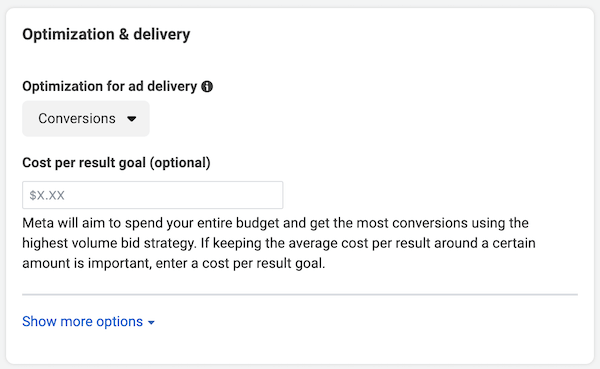
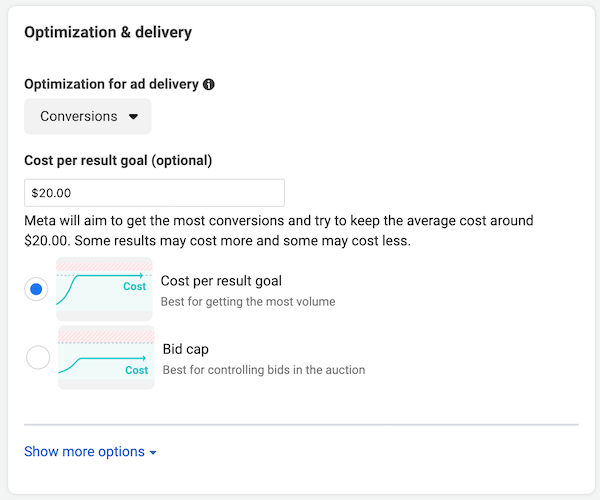
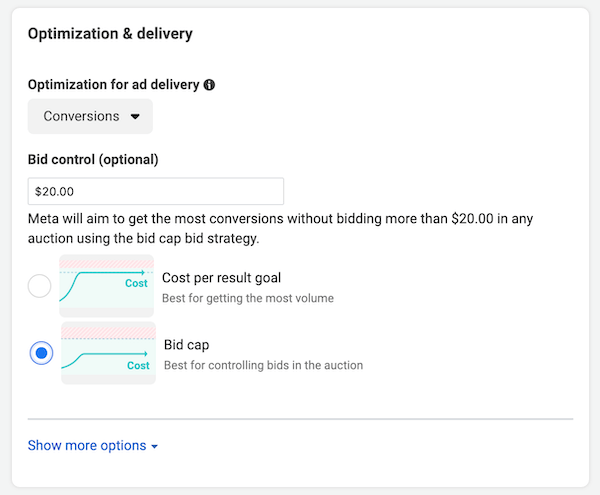






![The Complete Guide to Social Media Image Sizes in 2024 [Free Templates]](https://cdn.statically.io/img/www.wordstream.com/wp-content/uploads/2024/02/social-media-image-size-feature.jpg)
Comments
Please read our Comment Policy before commenting.